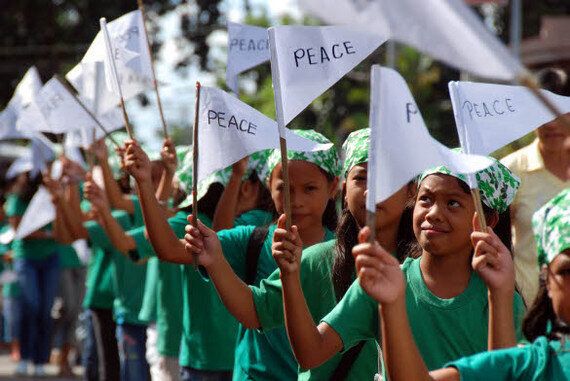
Credit: Ruel D. Ambatin
While the world focused on the Geneva II Conference on Syria, worried about the apparent intractability of that conflict, a very different sort of development has taken place in Kuala Lumpur, Malaysia. On Saturday the Government of the Philippines and the Moro Islamic Liberation Front (MILF) concluded sixteen years of negotiations seeking to putting an end to an armed conflict, which originated in 1968.
This is the most significant peace agreement in the world since the Comprehensive Peace Accord between the Government of Nepal and the Unified Communist Party of Nepal (Maoist) in 2006. The death toll in the last 40 years of conflict is said to have been about 150,000 and since 2000, nearly 3 million people have been displaced, according to the Internal Displacement Monitoring Centre.
The Comprehensive Agreement on the Bangsamoro (CAB) provides for the creation of a self-governing entity known as the Bangsamoro that will govern the Muslim-dominated areas in the island of Mindanao and the adjacent Sulu archipelago, within the Republic of the Philippines.
Although the war in Mindanao was not religiously motivated, Islam is the core bonding factor among the 16 ethno-linguistic groups in this part of a majority Christian country.
The struggle for self-determination of the Moro people - as they proudly call themselves - is rooted in the successful centuries long resistance against Spanish colonisation. Their narrative sustains that they were never consulted about joining the Philippines when it gained its independence from the US in 1948.
Over the course of the negotiations the MILF abandoned its claim for independence and the Government of the Philippines accepted significant devolution. Both parties thus became partners for peace and therefore equally interested in a successful implementation of their milestone agreement. The political arrangement is based on strengthening the democratic institutions, and may thereby become a reference for the rest of the country. As the Government argues: "What is good for the Bangsamoro is good for the Philippines."
In the regional context of ethnic conflict in Thailand, Myanmar and Indonesia, the Bangsamoro settlement is also becoming a regional mirror and source of inspiration.
More globally the combined support by Western, Asian and Muslim countries to the negotiations and the agreement implementation is also a welcome opportunity to show the power of dialogue and of joint efforts to peacefully settle conflicts with religious overtones.
Learning the lessons
Back in 1996 the Government already signed a Final Peace Agreement with the Moro National Liberation Front (MNLF) - the movement from which the MILF split. But as in so many other peace processes, the implementation phase was poorly devised, and parties are as of today still discussing a review of their commitments.
In addition to the importance of implementation, the Government and the MILF have also learned the relevance of inclusion.
The Bangsamoro entity will govern a plural society composed of multiple Muslim and non-Islamised ethno-linguistic groups, and a minority Christian population; a complex setting with multiple and overlapping layers of conflict. While full consensus among these groups would be unrealistic, the Government of the Philippines and the MILF have a shared understanding that unless social, economic and political stakeholders feel ownership of the outcome of the negotiations, change will not be possible.
Both panels have therefore engaged in countless consultations with mayors, governors, legislators, and leaders from the religious, academic, business, and security sectors. Civil society plays a prominent role. Non-governmental organisations (NGOs) have permanent access to both negotiating panels; some of them as part of the International Monitoring Team; and most conducting community education and consultation activities to strengthen the peace process.
Innovations in peacemaking
The Government and the MILF have faced three major breakdowns throughout their protracted negotiations. Each hurdle led to a new building block in the support architecture. In 2001 the parties asked the Malaysian government to host and facilitate the peace negotiations. In 2004 they agreed to an International Monitoring Team to verify the ceasefire. In 2009 the IMT added a human rights, a humanitarian and a civilian protection component.
Since 2009 an International Contact Group (ICG) has been observing the talks and assisting the parties and the facilitator. Composed of four states - Japan, the United Kingdom, Turkey and Saudi Arabia - and four international NGOs - Saint Egidio Community, Muhammadiyah, the Centre for Humanitarian Dialogue, and Conciliation Resources. The ICG is the only international mediation support mechanism, to date, that incorporates NGOs in formal negotiations.
Maybe the most relevant improvement is a clear roadmap for implementation, with sophisticated support architecture for issues such as decommissioning, policing, and transitional justice. A Third Party Monitoring Team (TPMT) will assess developments and eventually certify an Exit Agreement that will complete the implementation phase, ideally by mid-2016.
The process has been innovative in other aspects as well. Non-Islamised indigenous people have had a seat in both negotiating panels, thereby giving a voice and political power to marginalised groups.
Both panels have incorporated women in their negotiating teams, and paid special attention to linking the high-level talks with engagement at community level, when drafting the multiple partial agreements. The CAB is the first peace agreement ever negotiated and signed by a woman, Miriam Coronel-Ferrer, chair of the Government peace panel.
The peace agreement is indeed a major landmark, which will become the legacy of President Benigno Aquino and chairman of the MILF, Al Haj Murad Ebrahim. Expectations are high and the pressure for the Government and the MILF to deliver is strong. Building peace is a collective and long endeavour. A sustained commitment of national and international players is the best guarantee for long-term structural change.